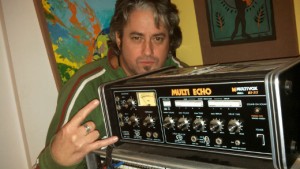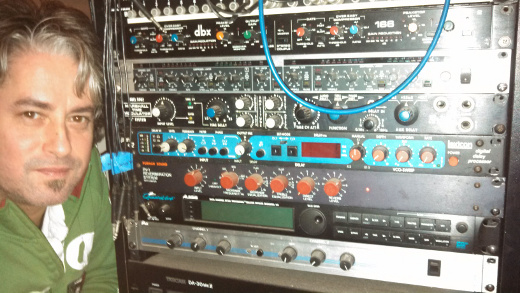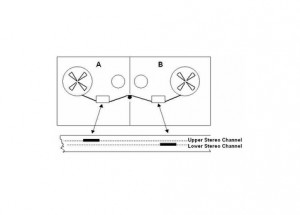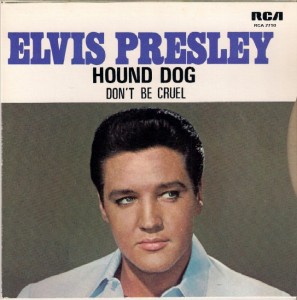All Mixed Up? Delay Is A Mixer’s Best Friend — by Jamey Staub
The latest in a series on raising your mix game, from the accomplished NYC mixer/producer Jamey Staub. Visit him early/often at http://www.jameystaub.com.
Delays Delays… How do I love thee. Let me count the ways. In fact, there are countless ways to use delays. Some of which I haven’t invented yet.
In this article I will discuss the many ways to use delays by order of time delay. Starting with short time delay and moving to longer delay, I will expose the nature of using analog and digital delay to enhance your mixes and produce big results.
History of Delay
The first use of time delay and sound recording was through analog tape delay. Tape machines employ a system that incorporates three magnetic heads. The magnetic (or iron oxide) tape is threaded through a trail of rollers, guides and metal heads that both read and write magnetic information to and from the iron particles embedded in the tape.
Without getting too technical, it is important to understand that the first head allows for erasure and bias, the second head allows for recording to tape and the third head provides playback of recorded material. The distance between the record head and the playback head provides a time delay of recorded sound to playback of sound. The length of the delay is dependent on the gap length and tape speed. The gap length is fairly standard in the construction of tape recorders; however the tape speed is easily controllable by the user/engineer. As the tape speed decreases the time lag from record head to playback head increases, resulting in a longer delay time.
Soon after tape delay was introduced, companies like Multivox and Roland designed tape echo machines that were compact and easy to use in the mixing process. Then, with the advent of digital semiconductor chips, digital delay evolved — my two favorite digital machines are the Lexicon PCM 41 and 42 and the TC 2290. There are also many plug-in delays such as EchoBoy, Tel-Ray and Moogerfooger which are fantastic.
Whatever you choose to use, remember that there is a wide variety of ways to be creative in your mixes.
Uses of Delay In Mixing/Recording Techniques
1. Phaser
2. Flange
3. Chorus
4. Doubling
5. Slapback
6. Echo
7. Delay
As I mentioned, I would like to describe and explain the use of delay by mixing engineers in simple terms, starting with minimal delay times and moving up to maximum delay times.
PHASING
The shortest delay time noticeable by the human ear is a few samples of digitally recorded music.
For example, if I take an overhead cymbal track in Pro Tools, duplicate it and then shift the duplicated track by a few samples, play it in addition to the original track, I can hear an anomaly that sounds like a swishing or swashing in the high frequency content. This is called phasing.
This sound is the result of the amplitude of the original frequency content being offset from the shifted frequency content resulting in changes of amplitude over time. If the additional track is modulated over time, the effect is more intense. The time difference that results in “phasing” is from a few microseconds to one millisecond.
A great example of this can be heard in one of my favorite songs ever – “Kashmir” by Led Zeppelin. If you listen to John Bonham’s cymbal crashes, you can hear this effect. In the 1970’s there was no digital recording so I believe the engineer used the wonderful Eventide Phaser unit.
An interesting note is that in the late 80’s, when we wanted to make sure two multitrack tape machines were synced together, we would bounce a high frequency signal (such as a high hat) from the original tape to the copy tape, adjust the synchronizer and listen to the two identical signals until the phasing was inaudible at which point we knew that the two machines were locked together.
Phasing is a fun and interesting way to enhance your mixes. For example, I love to use phasing on vocals, guitar solos, cymbals or even an entire drum loop. It is also effective if you only use it for a certain section of the song, such as the bridge.
FLANGE
As with Phasing, Flanging is an audio process that combines two copies of the same signal , with the second delayed slightly, to produce a swirling effect. The delay time is somewhere between 1 and 4 milliseconds.
The process originated before digital effect boxes and computer editing were available. The effect, invented in the early 1950s by Les Paul and later used by artists such as Jimi Hendrix and The Beatles, was originally created using two tape recorders.
Here’s how the non-digital process worked: While the original sound was being played from Tape Recorder #1, a second copy of the same audio material was played back from Tape Recorder #2. This process alone creates a hollow sound caused by the slight irregularities in the phase relationship of the audio waveforms. To get the flanging effect, the speed of the second recording was altered slightly. This was done most often by pressing a finger lightly on the 2nd tape reel’s “flange”, the large metal circle that surrounds and contains the tape on its hub. This created a time delay in addition to the phase differences, making the effect more pronounced.
One of my favorite examples of this is demonstrated in the song “Tomorrow Never Knows” from Revolver, which was recorded on April 6, 1966 . John Lennon’s lead vocal is flanged throughout the entire song. According to historian Mark Lewisohn, it was Lennon who actually gave the process the name “flanging”.
The first use of the flanging effect in stereo is credited to producer Eddie Kramer, who used the effect in the coda of Jimi Hendrix’s “Bold as Love” (1967). At around 2:46 the listener is led to believe that the song is over; however, Kramer edited in a flanged drum fill that leads to the outro, which was very innovative for that time. I love it because he used the effect on that single section thus making it more effective in the mix. To the right is a diagram of a stereo flange effect used by record producer Warren Kendrick whereby he could precisely control the effect by pressing a small tube on the tape itself.
Some interesting ways to use flange is flange an ad lib vocal, guitar or even flange reverb on strings.
If you are mixing in the box, there are several good choices of plugins to use. I like the Wavemachanics and TC plugins or I create my own by duplicating, let’s say a guitar track, applying delay to the duplicate and playing with delay time, modulation and feedback to get the desired result.
CHORUS
The chorusing effect is the next use of delay that arises from combining the original signal with a delayed signal at a time differential of greater than 5 or 6 milliseconds.
The easiest way to think of the chorus effect is to picture and hear a church choir. There are several if not 10’s of voices singing at the same time. As humans, we are not infallible and words and notes start and finish at different times. The use of the chorus effect in mixing replicates this by combining the original signal with a delayed and modulated signal. The goal and end result is to make few voices sound like many voices.
Or, a 6-string guitar can be made to sound like a 12-string guitar — I used this technique on Everlast’s first record Whitey Ford Sings the Blues, most notably on the single “Ends.”
To elaborate upon the vocal effect, let’s say you have a background singer who sings a melody and harmony on your song. By adding the chorus effect you delay each voice by 6 to 14 milliseconds. And, to make it more interesting and realistic, you add modulation. In basic terms, this means that the delay time is not constant, but changes over time, just as the aforementioned choir. Most effects units also provide the means to change pitch over time as well, which further enhances the many voice or chorus effect.
DOUBLING
A favorite delay technique among mixers and vocalists is called doubling. This delay is usually between 16 and 24 milliseconds. The concept here is to take the original vocal, delay it and modulate it so that it sounds as if the vocalist sang the part twice, on two different tracks.
I prefer to record a true double track, but sometimes I receive a single vocal track that just sounds better in the mix when I add the doubling or ADT (Automatic Double Tracking) effect. It is also very effective to pan the original to one side and the “double” to the opposite side.
To refer to one of the first artists to employ this technique, I turn again to John Lennon. One of the earliest uses of this effect can be heard on the song “I Am the Walrus” (which uses ADT in conjunction with equalization to help simulate a “fake stereo” effect on the second half of the stereo mix, which was sourced from the mono mix, by splitting the entire mix between the channels.)
Lennon asked Beatles producer George Martin to explain how ADT worked, and Martin answered with the nonsense explanation “now listen, it’s very simple: we take the original image and we split it through a double-bifurcated sploshing flange with double negative feedback.”
SLAPBACK
Slapback is a delay effect that utilizes delay times from 45 to 110 milliseconds.
The most common and well known demonstration of this effect is heard on many of Elvis Presley’s recordings. For instance “Hound Dog” has a clear vocal delay of, I believe, around 80 to 90 milliseconds. Many songs during the 50’s and 60’s utilized this effect and created a signature sound from studios like Sun Studio which was a recording studio opened by rock pioneer Sam Phillips at 706 Union Avenue in Memphis, Tennessee, on January 3, 1950. Other artists such as Johnny Cash, Jerry Lee Lewis and of course John Lennon used this sound effect over and over on many of their hit songs.
In today’s music, I don’t hear a lot of slapback, but it is generally used in Rock and Roll and always in Rockabilly styles. Again this is an effect I like to employ in certain sections to provide a change in the feel and excitement. I like it on lead vocal, guitar solo and also on drum fills. I also use the Marshall Time Modulator for Slapback as well as other wacky feedback effects. Two great plug ins are Tel Ray and the Moogerfooger Analog Delay.
ECHO
When I think of echo, I think of any delay time over 120 milliseconds and less than 300 MI. Remember going to a mountain overlooking a valley and yelling at the top of your lungs? Screaming in the alley, clapping your hands in the gym? Echo is the repeat of the original sound without any overlap of repeat sound to original sound.
When I mix and utilize echo, I think about the “Beats per Minute” of the song. In pop, rock and hip hop music it sounds cool if the echo is in time with the beat of the song. For example a song at 60 BPM means that there is one beat every second. An echo of 1/4th of a second (250 milliseconds) would repeat the sound four times every quarter note. An echo of 125 milliseconds would repeat the sound eight times every quarter note and so on.
I use this technique all the time with R&B music where there is a multi-voiced chorus section in the song. By adding an 1/8th note echo, the chorus sounds more full and harmonies are created as the lines develop in relation to the music.
This effect is easily heard in the song “Freak Like Me” by Adina Howard. For that mix, I used my beloved TC 2290 at an 1/8th note echo. It extends the vocal phrasing of the verse and chorus to create an interesting and intriguing sound that was not originally there.
If you combine the effect and, some of the previously discussed effects such as phasing and chorusing, you can make your mixes sound more interesting and professional.
DELAY
I classify delay as a timed repeat of the original signal greater than 300 milliseconds. This effect is especially useful in creating a moody, eerie and memorable listening experience. I often use delay to accentuate a certain line or phrase in the lyrics of a song.
A great example of this can be heard on Pink Floyd’s Dark Side of the Moon album. The song “Us and Them” utilizes this technique very well.
Another example is the delay I used on the chorus of “What It’s Like” by Everlast. The actual lyric that is delayed, is “What it’s Like”, the title of the song. In that case, the delay time, is a half note delay. By adding a filtered EQ effect to the delay, it became more interesting and memorable.
CONCLUSION
If I didn’t make it clear by now, I love mixing with delay. It is the most useful weapon in my arsenal. There are so many options and the coolest part is that I think of it as manipulating time and space. Delay is not only a mixer’s best friend but it will allow you to live long and prosper.
JAMEY STAUB is currently mixing a new album for Luscious Jackson. He is also involved in the creation of Music and Arts USA, a not for profit company whose mission is to bring music programs into NYC public schools that can not afford them due to budget cuts.
Please note: When you buy products through links on this page, we may earn an affiliate commission.











Bones Howell
January 14, 2013 at 9:31 pm (12 years ago)awesome post from an awesome engineer/mixer…thanks for the knowledge!!!!
Chris Webster
June 21, 2013 at 4:09 pm (12 years ago)A friend told me about X102.3 a few days ago. Now it’s programmed as number 1 on my car stereo. The music keeps me jamming, especially during their morning show. It’s always a great way to start my day. Tune in to http://www.thex1023.com, you may even win some tickets like I did.